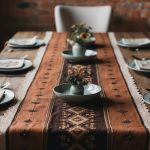Handmade Table Runners: Crafting a Personal Touch
Centerpieces and Accents
An eye-catching centerpiece can serve as the star of a table setup, complementing the handmade runner. Floral arrangements often make effective centerpieces; fresh blooms bring color and fragrance that can synchronize with the patterns of the runner. When selecting flowers, consider those in season for a natural touch.
Candles, sculptures, or seasonal items like pumpkins or pinecones offer alternative ways to enhance table decor. These can be chosen based on theme or occasion, such as elegant candlesticks for a formal dinner or seashells for a summer gathering. Balance is key, so ensure these accents do not overshadow the runner.
Placing smaller decorative elements like napkin rings or trinket holders can create additional points of interest. These subtle accents enhance the table’s overall theme, adding layers of intrigue and sophistication to the dining atmosphere.
Gifting Handcrafted Runners
Handcrafted table runners can make the perfect gift by allowing for a personalized touch and careful presentation. Through personalization, each table runner can become a unique statement, while thoughtful packaging enhances the gifting experience.
Personalization Ideas
Personalizing a handmade table runner turns a simple item into a cherished memento. Adding embroidered initials or a meaningful date can make it bespoke. Selecting colors or patterns that reflect the recipient’s style or home decor adds another layer of thoughtfulness.
For a more creative approach, consider incorporating family crests or important symbols. Using unique fabrics such as linen or cotton can match the recipient’s preferences. Personal touches not only make the gift unique but also show the giver’s attention to detail.
Packaging and Presentation
The way a gift is presented can enhance its impact. Carefully chosen packaging elevates the recipient’s experience and reflects the effort behind the thoughtful gift. Using tissue paper in complementary colors adds a pop of visual appeal.
Gift boxes or ornate bags can provide a polished look. Including a handwritten note can express personal sentiments and complete the package. The presentation should align with the runner’s style, creating a cohesive and welcoming impression. By focusing on presentation, the heartfelt nature of the handcrafted runner is beautifully showcased.
Maintenance and Storage
Maintaining the beauty and integrity of handmade table runners involves both effective cleaning techniques and mindful storage practices. By investing just a little time in these areas, the longevity and appearance of table runners can be greatly enhanced.
Cleaning Tips
Choosing the right cleaning method for handmade table runners is crucial. It is important to first determine the material, as this affects the cleaning process. For fabric runners, gentle hand washing with mild detergent in lukewarm water is often recommended. This method can help preserve delicate weaves and prevent fading. Air drying is preferable, so the runner retains its shape without risking shrinkage or wear from tumble dryers. Stain removal may require specialized care; applying a solution of baking soda and water can address common stains while being gentle on most fabrics. For non-fabric runners, like those made from wood or metal embellishments, simply dusting with a soft cloth helps to maintain their appearance without risking damage.
Proper Storage Solutions
Storing handmade table runners properly ensures they remain fresh and damage-free between uses. Fabric runners benefit from being rolled instead of folded to prevent creases from forming. Rolls can be stored in breathable fabric bags or tubes to protect against dust, pests, and direct sunlight. For runners with intricate details, placing acid-free tissue between layers can minimize abrasion and discoloration. Non-fabric table runners, such as those with decorative elements, should be stored in a manner that minimizes pressure on delicate features, possibly in flat, padded boxes. Keeping runners in a clean, cool, and dry area helps prevent damage from humidity and temperature fluctuations.



